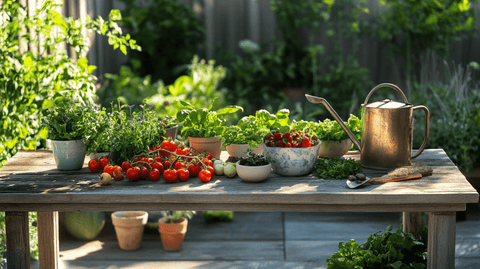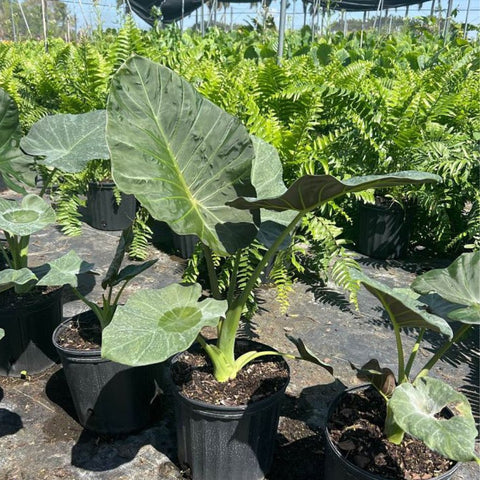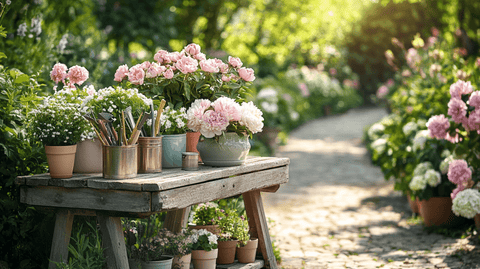Introduction
Spring is a time of renewal and rebirth, a season when nature wakes from its winter slumber and bursts into vibrant life. For gardeners, it's a magical time where the earth becomes a canvas ready to be painted with a palette of fruits and vegetables. Planting in spring is not just a hobby but a joyous celebration of nature's bounty and the beginning of a journey towards a nutritious harvest.
This comprehensive guide is crafted to aid gardeners in selecting the best fruits and vegetables to plant in the spring season. With careful consideration of timing and choice, planting during this period can lead to a thriving garden that reaps generous rewards. At Plantology, we are dedicated to providing you with top-tier plants and ensuring your gardening experience is as fruitful as possible.

Understanding Spring Planting
2.1. Why Spring is the Ideal Season
Spring represents a fresh start, the ideal moment to sow seeds that will flourish in the long, sun-filled days of summer. The season offers optimal planting conditions with its mild temperatures, increasing daylight, and ample rainfall, which create a favorable environment for many fruits and vegetables to establish strong roots.
2.2. Preparing Soil for Spring Planting
Before planting, it's crucial to prepare your soil to ensure it supports healthy growth. Begin by clearing any debris from the winter. Then, test your soil's pH and amend it with compost or organic matter to enhance its fertility. This preparation lays the groundwork for a bountiful garden.
Fruits to Plant in Spring
3.1. Strawberries
Strawberries are one of the most rewarding fruits to plant in spring. With their sweet taste and versatile use, they make a delightful addition to any garden. Choose a sunny spot with well-drained soil, and you'll have fresh strawberries ready for picking in late spring to early summer.
3.2. Blueberries
Blueberries thrive in acidic soil with a pH of 4.5 to 5.5. These perennial bushes start producing after a couple of years and are worth the wait. They provide not only delicious berries but also beautiful foliage that changes color throughout the year.

3.3. Raspberries
Raspberries are perfect for growing in the cool temperatures of spring. They prefer full sun and well-draining soil. With a little care, raspberries can produce an abundant harvest every year.
Vegetables to Plant in Spring
4.1. Spinach
Spinach is a cool-weather crop, making spring the ideal time to plant. Its fast-growing nature ensures you can enjoy its tender leaves in as little as 4-6 weeks. Plant spinach in rich, well-draining soil to encourage healthy growth.
4.2. Carrots
Carrots require loose, sandy soil to accommodate their long roots. These nutritious root vegetables are easy to grow and offer a crunchy, flavorful harvest. Ensure consistent moisture for the best results.
4.3. Lettuce
Lettuce is another quick-growing crop ideal for spring planting. With varieties available in a multitude of colors and textures, you can enjoy fresh, crisp salads straight from your garden throughout the growing season.
4.4. Tomatoes
Plant tomatoes when the last frost has passed, as they require warmer temperatures to thrive. Choose a sunny spot and provide support as the plants grow. Tomatoes from your own garden are unmatched in flavor.

Additional Tips for Successful Spring Planting
5.1. Choosing the Right Varieties
Select plant varieties that align with your climate and garden conditions. Opt for disease-resistant types to minimize pest issues and enhance crop success.
5.2. Timing is Everything
Consider your local climate zones and average frost dates. Plant early-harvest crops first, followed by longer-growing varieties.
Enhance Your Garden with Plantology
Discover the perfect plants for your garden at Plantology. Whether you're planting fruit trees or vibrant vegetables, our wide selection ensures you find exactly what you need to bring your garden dreams to life.
6.1. Explore Our Selection
Our collection includes a variety of plants and trees, from the majestic Adonidia Palm to exotic Agapanthus - Lily of the Nile Blue. Each product is carefully curated for quality and vigor.
6.2. Shop With Assurance
At Plantology, we're committed to providing exceptional service and premium plants. Explore our full range today and start your spring garden planning with confidence.
Conclusion
Embrace the warmth and vitality of spring by cultivating a garden filled with delectable fruits and vegetables. With proper preparation and selection, your efforts will be rewarded with a flourishing landscape and a bountiful harvest. Visit Plantology to find plants that align with your garden's potential and enjoy the transformative journey of spring gardening.

Understanding Spring Planting in Depth
2.3. The Role of Climate and Geographic Location
The success of spring planting hinges largely on understanding your local climate and geographic nuances. Different regions experience spring differently, impacting when and how you should plant. For instance, southern areas may have shorter, milder winters allowing earlier planting, while northern regions may need to wait longer for the last frost to pass. Familiarize yourself with the USDA Hardiness Zones, which guide planting times based on local minimum winter temperatures.
Additionally, consider microclimates within your garden area. Factors like sun exposure, wind patterns, and proximity to bodies of water can affect how and when plants thrive. Understanding these subtleties can help tailor your planting strategy for greater success.
2.4. Tools for Successful Spring Planting
Arming yourself with the right tools can make spring planting more efficient and effective. Basic essentials include quality gloves for protection, a reliable trowel or hand shovel for planting, a watering can or hose with a gentle spray nozzle, and pruners for trimming and harvesting. Invest in a soil thermometer to accurately gauge soil temperature, a critical factor in determining when to plant certain crops.
For larger gardens, consider more advanced equipment like a rototiller for preparing soil and, if you have an extensive garden, a drip irrigation system to ensure consistent watering. Usage of such tools, while investing slightly higher initially, pays off in the blossoming health of your garden.

Maximizing Yield from Fruit Planting
3.4. Apple Trees
Apple trees are an excellent addition to any spring garden. When choosing apple varieties, consider cross-pollinating types to maximize yield. Apple trees require full sun and well-drained loamy soil. Keep the area around the base free from weeds and mulch in early spring to retain soil moisture.
Pruning plays a critical role in apple tree care, promoting air circulation and enabling sunlight to penetrate the canopy, which is essential for fruit development. Planting companion plants like chives or garlic can also deter pests naturally and enhance the health of your apple trees.
3.5. Cherry Trees
Cherry trees, whether sweet or sour, are a wonderful fruit option. They need a well-draining location with full sun exposure. Sweet cherries often require cross-pollination, so plant compatible varieties close together. Sour cherries are generally self-pollinating.
Protection from birds, who are very fond of cherry fruit, is necessary. Implementing netting during fruiting season can protect your harvest. Keep the base of the tree mulched and pruned to encourage proper growth and fruit production.

Advanced Vegetable Planting Techniques
4.5. Broccoli
Broccoli is a nutritious spring vegetable that thrives in cooler weather. Start seeds indoors about 6 weeks before the last expected frost, then transplant seedlings outdoors after hardening them off. Broccoli prefers fertile, well-drained soil and consistent moisture.
Interplanting with aromatic herbs such as dill or basil can repel pests and improve growth. Regular harvesting of the central head encourages the growth of side shoots, extending your broccoli harvest.
4.6. Peas
Peas are a spring favorite known for their sweet flavor and ease of growth. Sow seeds directly into the garden as soon as the soil can be worked. Choose a sunny location and ensure the soil stays moist but not waterlogged.
Use trellises or stakes to support climbing pea varieties. Companion planting with carrots or radishes can maximize garden space and improve soil conditions for surrounding plants.
4.7. Beets
Beets are a versatile vegetable that offers both edible roots and greens. They thrive in well-drained, loamy soil with a neutral to slightly acidic pH. Thin beet seedlings early to prevent crowding and encourage larger root development.
Regular watering ensures tender, flavorful beets, and mulching helps maintain consistent soil moisture. Incorporating beets in your spring garden provides a continuous harvest, as both early and late sowings yield well throughout the growing season.

Companion Planting for Improved Results
5.3. Benefits of Companion Planting
Companion planting is a strategic approach to gardening that involves planting complementary species near each other to enhance growth, deter pests, and improve flavor. This technique not only maximizes garden space but also enriches soil nutrients and reduces the need for chemical interventions.
For example, planting basil next to tomatoes can enhance tomato flavors and repel pests such as mosquitoes and whiteflies. Similarly, marigolds, when interplanted with vegetables, can effectively deter nematodes and aphids from setting in.
5.4. Designing a Companion Planting Plan
Crafting a companion planting plan requires an understanding of plant needs and interactions. Group plants with similar sunlight and watering requirements, but avoid combinations that compete for the same nutrients. Use climbing plants strategically with ground-hugging species for vertical garden optimization.
Create garden sections based on plant families, such as grouping nightshades together or the brassica family which can share similar pest-repelling companions. Document the plan to make tweaks based on seasonal changes or past harvest records.
Szpring Gardening Challenges and Solutions
6.3. Managing Pests Naturally
Spring gardens often invite a variety of pests that can threaten young plants. Natural pest management involves incorporating biological controls like ladybugs for aphids, using neem oil for fungal issues, or introducing beneficial nematodes to control soil-dwelling pests.

Encourage biodiversity by planting a range of flowers and herbs that attract beneficial insects and birds. Netting and row covers offer physical barriers and are particularly effective against birds and insects. Crop rotation and annual garden cleanup reduce overwintering pest populations.
6.4. Coping with Unpredictable Weather
The erratic nature of spring weather can pose challenges, such as unexpected frosts or unseasonably warm spells. Use cloches or floating row covers to protect young seedlings from frost. Ensure proper watering and mulching during dry spells to maintain soil moisture.
Stay informed with local weather forecasts and maintain a toolkit of plant protection strategies. These proactive measures help mitigate weather-related risks, ensuring the vitality of your spring crops.
Building a Sustainable Future with Your Garden
7.1. Embracing Organic Practices
Organic gardening fosters a healthy ecosystem by reducing chemical use and promoting natural growth processes. Employ organic fertilizers and soil amendments, such as bone meal, blood meal, and well-rotted manure, which enrich the soil matrix without harmful residue.
Implement organic disease control by pruning diseased plant material and employing preventative practices such as crop rotation and diversifying plant species.

7.2. Water Conservation Techniques
Water conservation is crucial for sustainable gardening, particularly in regions susceptible to drought. Utilize drip irrigation systems that deliver water directly to plant roots, minimizing evaporation. Collect rainwater using barrels to reduce reliance on municipal water supplies.
Design gardens with drought-tolerant and native species where feasible. Group plants with similar water needs together to streamline watering efforts. Mulching greatly aids in moisture retention, creating a more resilient garden.
7.3. Promoting Pollinators
Pollinators like bees, butterflies, and hummingbirds are essential for garden success. Grow a variety of nectar-rich flowers such as sunflowers, zinnias, and foxgloves to attract these vital creatures. Choose single-flowered species to provide easy access to pollen and nectar.
Incorporate native plants that sympathetically align with local pollinator species. Eliminate or minimize pesticide use, opting for natural pest control methods that do not harm beneficial insect populations.
Engage with Plantology's Spring Planting Resources
8.1. Join Our Community
Engage with a community of passionate gardeners through Plantology's online forums and social media channels. Share your experiences, seek advice, and discover new planting techniques that enhance your gardening journey.

8.2. Sign Up for Workshops and Events
Plantology hosts regular workshops and events focusing on various aspects of gardening, from organics to advanced hydroponic systems. Stay informed by subscribing to Plantology's newsletter for updates about upcoming events and special promotions.
8.3. Access Expert Gardening Guides
Our extensive library of gardening guides provides in-depth knowledge on all aspects of spring planting. From novice to seasoned gardener, find tips and tricks to push your gardening skills to new heights. Visit our website for access to a wealth of resources tailored to your gardening goals.
Conclusion
Spring is an opportune time to cultivate a garden overflowing with the season's freshest fruits and vegetables. With a thoughtful approach to planting, preparation, and care, your garden will






























Comments (0)
There are no comments for this article. Be the first one to leave a message!